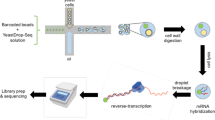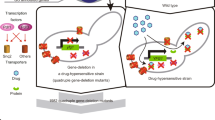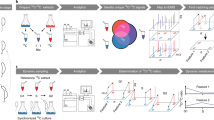Abstract
Identification of the cellular targets of small-molecule hits in phenotypic screens is a central challenge in the development of small molecules as biological tools and potential therapeutics. To facilitate the process of small-molecule target identification, we developed a global, microarray-based method for monitoring the growth of pools of yeast strains, each overexpressing a different protein, in the presence of small molecules. Specifically, the growth of Saccharomyces cerevisiae strains harboring ∼3,900 different overexpression plasmids was monitored in the presence of rapamycin, which inhibits the target of rapamycin (TOR) proteins. TOR was successfully identified as a candidate rapamycin target, and many additional gene products were implicated in the TOR signaling pathway. We also characterized the mechanism of LY-83583, a small-molecule suppressor of rapamycin-induced growth inhibition. These data enabled functional links to be drawn between groups of genes implicated in the TOR pathway, identified several candidate targets for LY-83583, and suggested a role for mitochondrial respiration in mediating rapamycin sensitivity.

This is a preview of subscription content, access via your institution
Access options
Subscribe to this journal
Receive 12 print issues and online access
$259.00 per year
only $21.58 per issue
Buy this article
- Purchase on Springer Link
- Instant access to full article PDF
Prices may be subject to local taxes which are calculated during checkout





Similar content being viewed by others
References
Harding, M.W., Galat, A., Uehling, D.E. & Schreiber, S.L. A receptor for the immunosuppressant FK506 is a cis-trans peptidyl-prolyl isomerase. Nature 341, 758–760 (1989).
Sigal, N.H., Dumont, F.J. Cyclosporin A FK-506, and rapamycin: pharmacologic probes of lymphocyte signal transduction. Annu. Rev. Immunol. 10, 519–560 (1992).
Heitman, J., Movva, N.R. & Hall, M.N. Targets for cell cycle arrest by the immunosuppressant rapamycin in yeast. Science 253, 905–909 (1991).
Brown, E.J. et al. A mammalian protein targeted by G1-arresting rapamycin-receptor complex. Nature 369, 756–758 (1994).
Chiu, M.I., Katz, H. & Berlin, V. RAPT1, a mammalian homolog of yeast Tor, interacts with the FKBP12/rapamycin complex. Proc. Natl. Acad. Sci. USA 91, 12574–12578 (1994).
Sabatini, D.M., Erdjument-Bromage, H., Lui, M., Tempst, P. & Snyder, S.H. RAFT1: a mammalian protein that binds to FKBP12 in a rapamycin-dependent fashion and is homologous to yeast TORs. Cell 78, 35–43 (1994).
Jacinto, E. & Hall, M.N. Tor signalling in bugs, brain and brawn. Nat. Rev. Mol. Cell Biol. 4, 117–126 (2003).
Crespo, J.L. & Hall, M.N. Elucidating TOR signaling and rapamycin action: lessons from Saccharomyces cerevisiae. Microbiol. Mol. Biol. Rev. 66, 579–591 (2002).
Shamji, A.F., Nghiem, P. & Schreiber, S.L. Integration of growth factor and nutrient signaling: implications for cancer biology. Mol. Cell 12, 271–280 (2003).
Inoki, K., Corradetti, M.N. & Guan, K.L. Dysregulation of the TSC-mTOR pathway in human disease. Nat. Genet. 37, 19–24 (2005).
Huang, J. et al. Finding new components of the target of rapamycin (TOR) signaling network through chemical genetics and proteome chips. Proc. Natl. Acad. Sci. USA 101, 16594–16599 (2004).
Giaever, G. et al. Functional profiling of the Saccharomyces cerevisiae genome. Nature 418, 387–391 (2002).
Winzeler, E.A. et al. Functional characterization of the S. cerevisiae genome by gene deletion and parallel analysis. Science 285, 901–906 (1999).
Giaever, G. et al. Genomic profiling of drug sensitivities via induced haploinsufficiency. Nat. Genet. 21, 278–283 (1999).
Lum, P.Y. et al. Discovering modes of action for therapeutic compounds using a genome-wide screen of yeast heterozygotes. Cell 116, 121–137 (2004).
Giaever, G. et al. Chemogenomic profiling: identifying the functional interactions of small molecules in yeast. Proc. Natl. Acad. Sci. USA 101, 793–798 (2004).
Rine, J., Hansen, W., Hardeman, E. & Davis, R.W. Targeted selection of recombinant clones through gene dosage effects. Proc. Natl. Acad. Sci. USA 80, 6750–6754 (1983).
Chan, T.F., Carvalho, J., Riles, L. & Zheng, X.F. A chemical genomics approach toward understanding the global functions of the target of rapamycin protein (TOR). Proc. Natl. Acad. Sci. USA 97, 13227–13232 (2000).
Xie, M.W. et al. Insights into TOR function and rapamycin response: chemical genomic profiling by using a high-density cell array method. Proc. Natl. Acad. Sci. USA 102, 7215–7220 (2005).
Parsons, A.B. et al. Integration of chemical-genetic and genetic interaction data links bioactive compounds to cellular target pathways. Nat. Biotechnol. 22, 62–69 (2004).
Mulsch, A., Busse, R., Liebau, S. & Forstermann, U. LY 83583 interferes with the release of endothelium-derived relaxing factor and inhibits soluble guanylate cyclase. J. Pharmacol. Exp. Ther. 247, 283–288 (1988).
Mulsch, A., Luckhoff, A., Pohl, U., Busse, R. & Bassenge, E. LY 83583 (6-anilino-5,8-quinolinedione) blocks nitrovasodilator-induced cyclic GMP increases and inhibition of platelet activation. Naunyn Schmiedebergs Arch. Pharmacol. 340, 119–125 (1989).
Kiser, G.L. & Weinert, T.A. GUF1, a gene encoding a novel evolutionarily conserved GTPase in budding yeast. Yeast 11, 1311–1316 (1995).
Hughes, T.R. et al. Functional discovery via a compendium of expression profiles. Cell 102, 109–126 (2000).
Leinders-Zufall, T. & Zufall, F. Block of cyclic nucleotide-gated channels in salamander olfactory receptor neurons by the guanylyl cyclase inhibitor LY83583. J. Neurophysiol. 74, 2759–2762 (1995).
Prasad, R.K., Behrooz, A. & Ismail-Beigi, F. LY-83583 stimulates glucose transporter-1-mediated glucose transport independent of changes in cGMP levels. Eur. J. Pharmacol. 366, 101–109 (1999).
Marchler-Bauer, A. et al. CDD: a Conserved Domain Database for protein classification. Nucleic Acids Res. 33, D192–D196 (2005).
Hardwick, J.S., Kuruvilla, F.G., Tong, J.K., Shamji, A.F. & Schreiber, S.L. Rapamycin-modulated transcription defines the subset of nutrient-sensitive signaling pathways directly controlled by the Tor proteins. Proc. Natl. Acad. Sci. USA 96, 14866–14870 (1999).
Liu, C.L., Schreiber, S.L. & Bernstein, B.E. Development and validation of a T7 based linear amplification for genomic DNA. BMC Genomics 4, 19 (2003).
Gollub, J. et al. The Stanford Microarray Database: data access and quality assessment tools. Nucleic Acids Res. 31, 94–96 (2003).
Acknowledgements
The authors thank M. Hall for the gift of the fpr1-8 strain, C.L. Liu for advice regarding the in vitro transcription amplification strategy and for help with data analysis, and A. Shamji for a careful reading of this manuscript. This work was supported by GM38627 (awarded to S.L.S.). The construction of the collection of yeast overexpression plasmids was supported by National Human Genome Research Institute R01-HG002923 (awarded to J.L.). S.L.S. is an Investigator at the Howard Hughes Medical Institute. R.A.B. was supported by a graduate fellowship from the National Science Foundation.
Author information
Authors and Affiliations
Corresponding author
Ethics declarations
Competing interests
The authors declare no competing financial interests.
Supplementary information
Supplementary Fig. 1
Analysis of amplification method. (PDF 256 kb)
Supplementary Fig. 2
Correlation plot for the two replicate microarray experiments of rapamycin treatment. (PDF 428 kb)
Supplementary Fig. 3
Wild-type yeast are hypersensitive to LY-83583 on non-fermentable carbon sources. (PDF 172 kb)
Supplementary Fig. 4
Inhibition of Guf1p GTPase activity by LY-83583. (PDF 204 kb)
Supplementary Table 1
Overexpression strains that showed resistance or hypersensitivity to rapamycin. (PDF 47 kb)
Supplementary Table 2
Complete data set. (XLS 865 kb)
Supplementary Table 3
Retesting of the rapamycin sensitivity of strains that were enriched or depleted after rapamycin treatment. (PDF 14 kb)
Supplementary Table 4
Retesting of the LY-83583 sensitivity of strains that were enriched or depleted after LY-83583 treatment. (PDF 15 kb)
Rights and permissions
About this article
Cite this article
Butcher, R., Bhullar, B., Perlstein, E. et al. Microarray-based method for monitoring yeast overexpression strains reveals small-molecule targets in TOR pathway. Nat Chem Biol 2, 103–109 (2006). https://doi.org/10.1038/nchembio762
Received:
Accepted:
Published:
Issue Date:
DOI: https://doi.org/10.1038/nchembio762
This article is cited by
-
From beer to breadboards: yeast as a force for biological innovation
Genome Biology (2024)
-
Utilizing yeast chemogenomic profiles for the prediction of pharmacogenomic associations in humans
Scientific Reports (2016)
-
Tuberous sclerosis complex neuropathology requires glutamate-cysteine ligase
Acta Neuropathologica Communications (2015)
-
Functional genomics to uncover drug mechanism of action
Nature Chemical Biology (2015)
-
Opposing effects of target overexpression reveal drug mechanisms
Nature Communications (2014)



